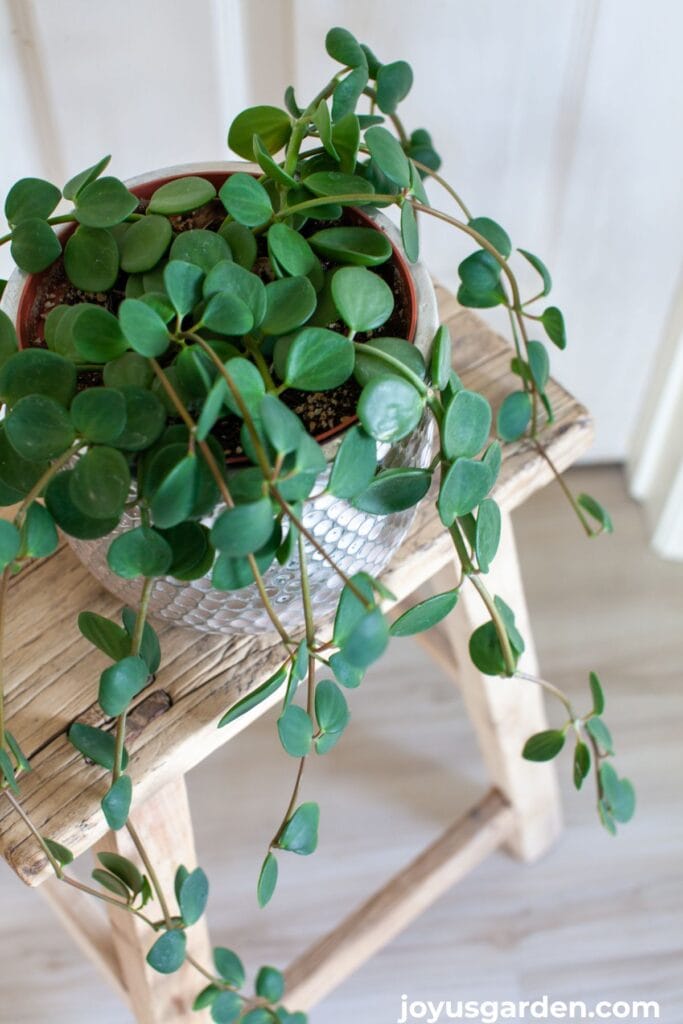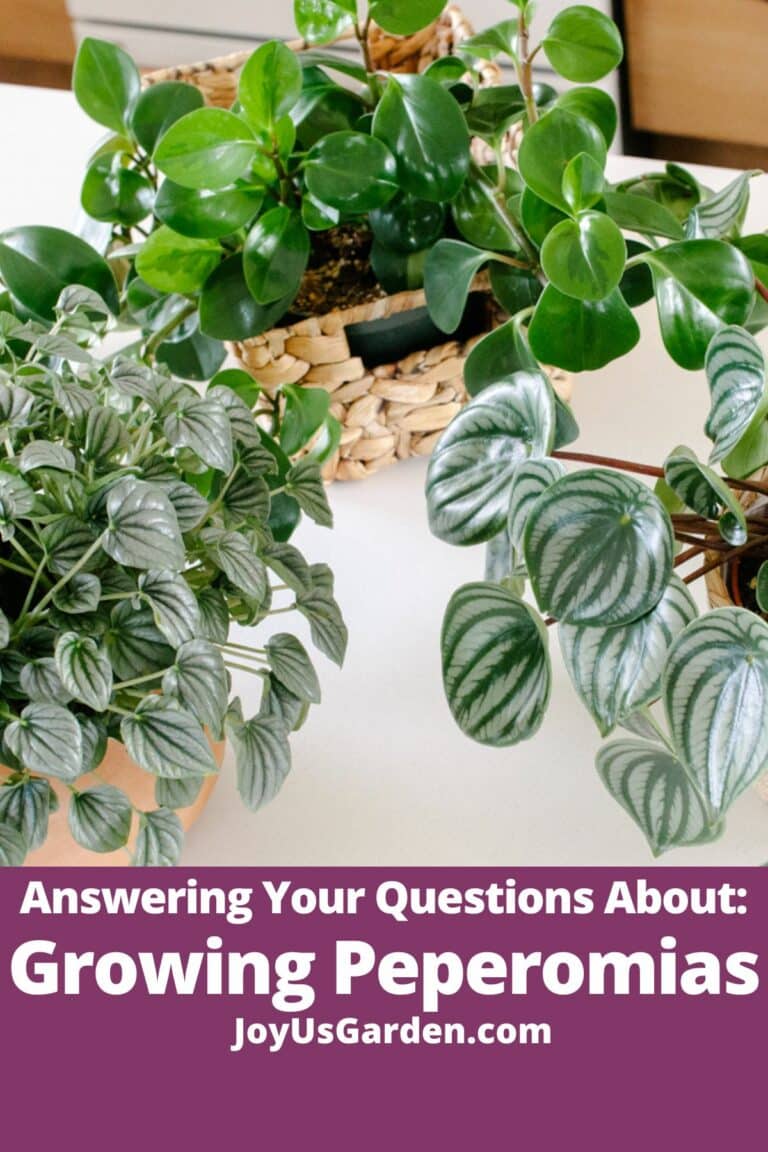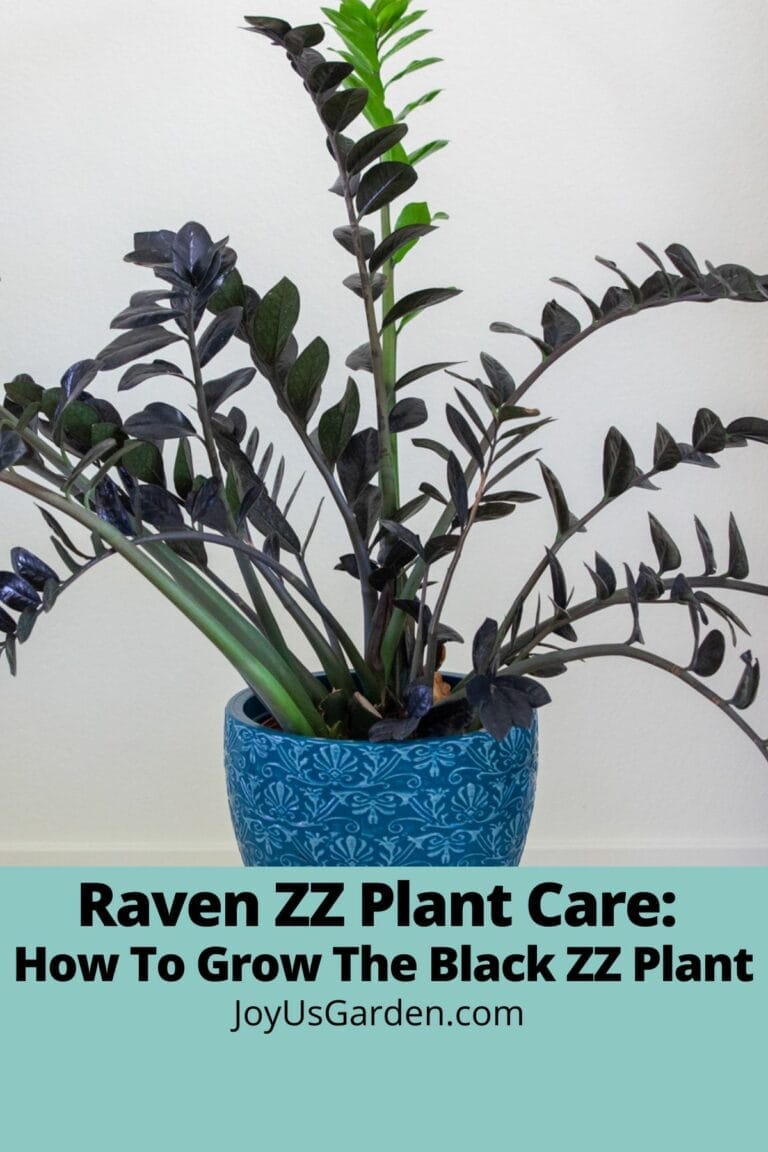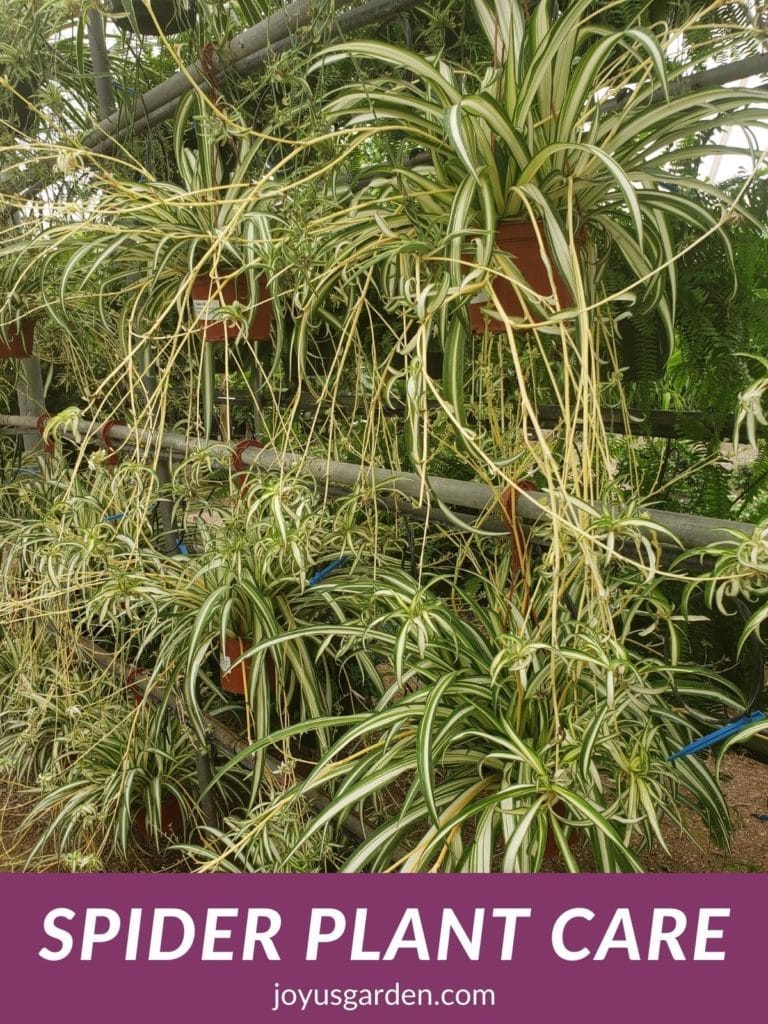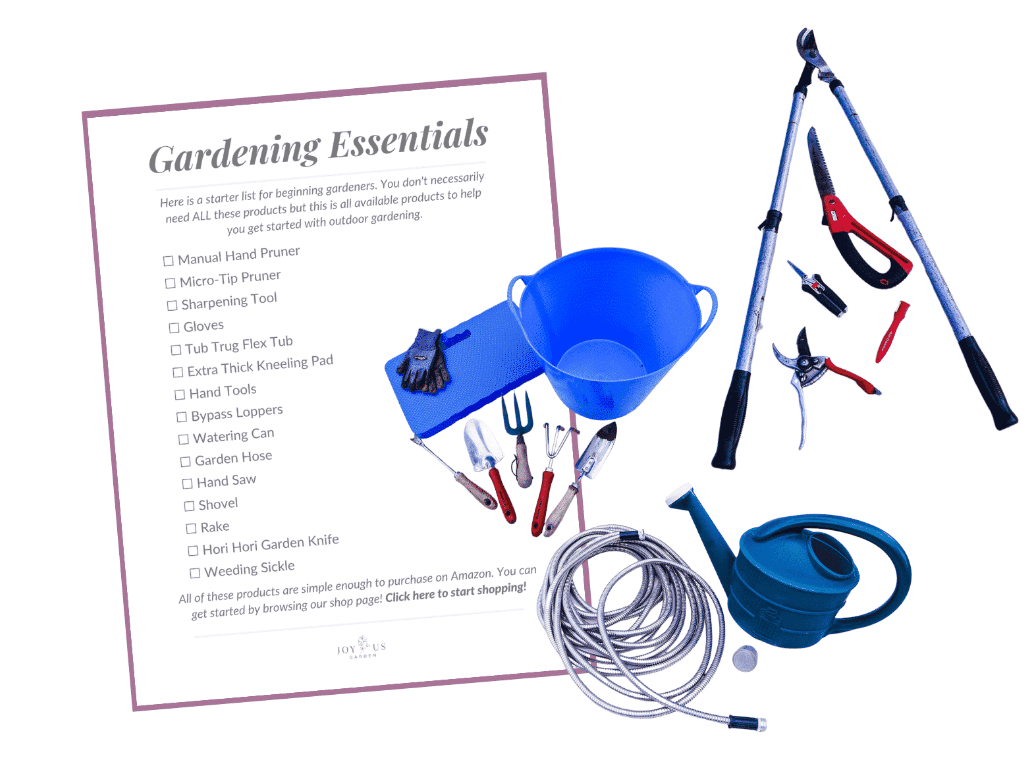Peperomia Care Tips: A Complete Growing Guide
Peperomias are charming little plants that share some care similarities with hoyas. Both have fleshy leaves and stems, giving them a succulent-like quality. Peperomias make delightful and easygoing houseplants, whether trailing from a hanging basket or growing upright on a shelf. This post covers everything you need to know about peperomia care to keep these sweet beauties thriving.
I used to grow a couple of peperomias in containers in my Santa Barbara garden, where they enjoyed bright shade and the gentle touch of coastal fog. Now that I live in Tucson, in the sunny Sonoran Desert, I grow them indoors, just like most of you do.
There are many types of peperomias available, and the care tips in this post apply to all of them. As a whole, peperomia plants are generally called radiator plants.
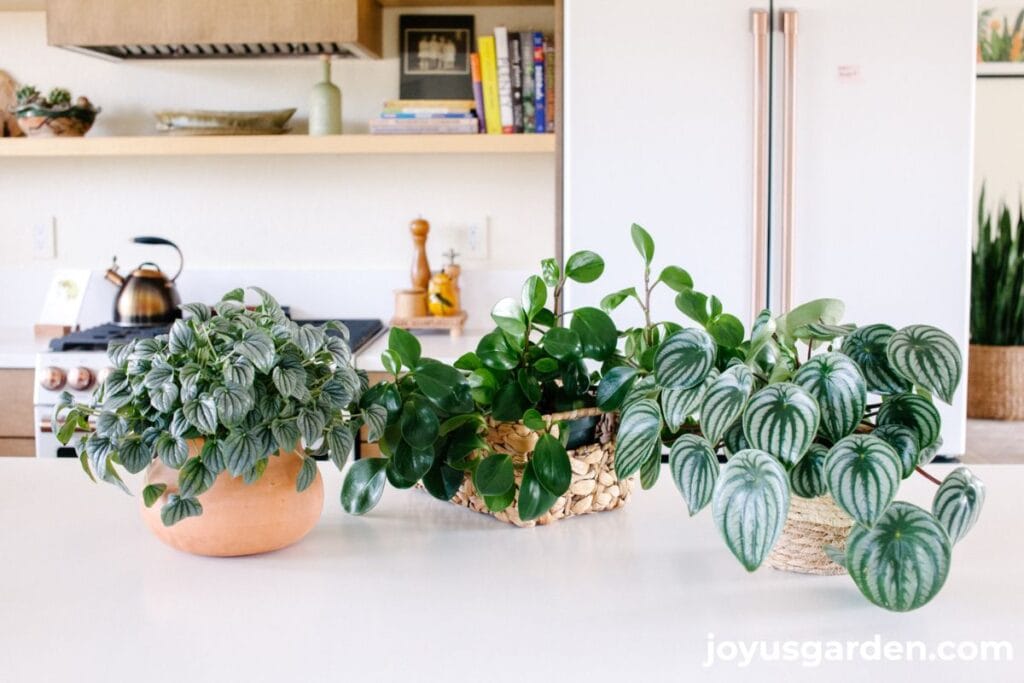
Peperomia Care & Growing Tips
The ones I have: Baby Rubber Plant, Variegated Baby Rubber Plant, Peperomia obtusifolia variegata, Watermelon Peperomia, Peperomia Hope, Raindrop Peperomia, Peperomia Tricolor, and Ripple Peperomia. Check out all our Peperomia posts for lots of growing tips.
Uses
Most peperomias are used as tabletop plants, in dish gardens and terrariums. Of course, the trailing species and varieties are used as hanging plants.
Size
Most don’t grow much bigger than 12″ tall and wide, except the Baby Rubber Plant and Raindrop Peperomia. The trails of the hanging ones can grow longer. Still, overall Peperomias are small houseplants. They’re most commonly sold in 2″, 4″, and 6″ grow pot sizes.
Growth Rate
I find most peperomias to be moderate to slow growers. My Baby Rubber Plant and Raindrop Peperomia grow the fastest. I need to prune them once or twice a year to keep the stems from flopping over.
Main Draw
It’s all about the foliage—peperomia plants have eye-catching, glossy leaves in various colors, shapes, and textures. With so much variety in size and form, there’s a peperomia for just about every space. They’re compact and can be tucked into small spaces or added to a plant shelf.
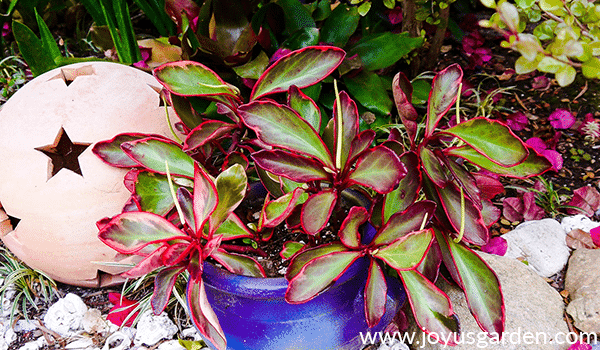
Light Requirements
Mine do best in moderate or medium light conditions. That being said, some peperomias will tolerate low light conditions, but you won’t see a lot of growth. If the plant is getting leggy and the leaves are smaller and paler, move it to a spot with brighter light.
The more color or variegation your peperomia has, the more light it’ll need to bring out and maintain those patterns. Just be sure to keep it out of direct sun—hot, sunny windows can scorch the leaves. About 5–10 feet back from a south or west-facing window is usually a safe spot.
In the darker winter months, you may have to move your Peperomia closer to a light source.
If your peperomia is getting light on one side only and leaning towards the light source, you’ll have to rotate it as needed to grow straight.
Water Requirements
Mine get watered once every 7 – 12 days in the warmer months, depending on the type. I let my peperomias go almost dry before watering them again.
Generally, thick-leafed and stemmed varieties (like the Baby Rubber Plant) prefer to dry out more between waterings. Thinner-leafed and stemmed varieties (Ripple Peperomia) like slightly more consistent moisture.
Even though this plant doesn’t like to dry out for too long, it doesn’t want to stay sopping wet or sit in a saucer of water. Many peperomias are succulent-like epiphytic plants (their roots are used for anchoring and not as much for water collection) and will rot out if kept too wet.
In the winter months, I water them less often – every 14 days. This isn’t the active growing season for houseplants, so I cut back on the watering frequency. Too much water can lead to fungal diseases, especially in cooler months. And, I use room temperature water for all my indoor plants.
Your peperomia might need watering more or less often depending on the pot size, type of soil it’s planted in, the location where it’s growing, the season, and your home’s environment.
If you’re new to houseplant gardening, this guide to watering indoor plants will help you out.
Temperature
If your home is comfortable for you, it’ll be so for your houseplants too. Just be sure to keep your peperomias away from any cold drafts as well as air conditioning or heating vents.
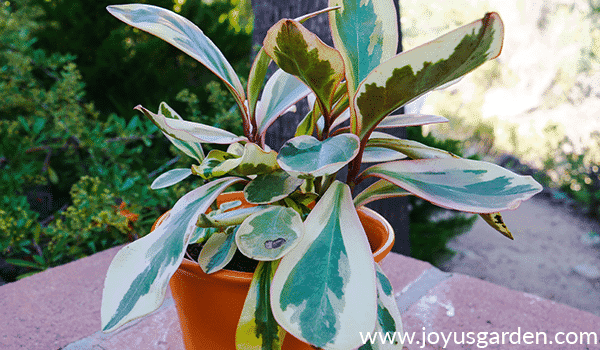
Humidity
Peperomias are tropical plants that grow in high humidity environments in nature and love it. Because their root systems are small, they also collect water through their leaves.
Because I live in the desert, the humidity is low most of the year. I use a simple, inexpensive humidity reader to track the humidity level, and I run tabletop humidifiers when the humidity drops below 25%, which is a common occurrence. I also mist mine every week or two.
You could mist yours also if your home is dry and you think it needs it. Another option would be to fill a pebble tray or saucer with water and then set the plant on top of that. The rock keeps the roots from submerging in the water.
Fertilizing/Feeding
During the active growing season, I fertilize my peperomias every four weeks. Here in Tucson, that season runs long, from mid-February through October/early November. I alternate using a few fertilizers, including Grow Big, Liquid Kelp, and Maxsea or Sea Grow. I alternate these fertilizers monthly and don’t mix them all together.
Your start date may be later in a different climate zone with a shorter season. Feeding three to five times yearly with a houseplant fertilizer may be enough for your plants.
Fertilizing too often or with too great a fertilizer ratio can cause salts to build up and eventually cause root and leaf burn. This will show up as brown edges and spots on the leaves. If you fertilize more than three times a year, you can try using the fertilizer at half-strength. The label on the jar or bottle will guide you.
You don’t need to fertilize houseplants in late fall or winter because it’s not their active growing season. Be sure to avoid fertilizing a stressed houseplant, ie, bone dry or soaking wet.
Here’s a general guide to feeding houseplants with lots of tips.
Repotting/Soil
Like fertilizing, the best time to repot is in spring and summer, and into early fall if you’re in a temperate climate.
Their root systems are small, so they don’t need repotting often. I repot mine every five years or so to freshen the soil mix or if the roots are coming out of the bottom. And, I only go up a pot size. Make sure the pot has at least one drainage hole on the bottom of the pot so the excess water can freely flow out.
These plants love a rich, chunky, and well-draining potting mix. I now use a 1:1 mix of potting soil and my DIY succulent and cactus mix. It’s packed with coco chips and coco coir, a more sustainable alternative to peat moss, which peperomias enjoy. I also mix in a few handfuls of compost and top it off with some worm compost for an extra boost.
For more details, you can check the post and video that focuses on repotting peperomias.
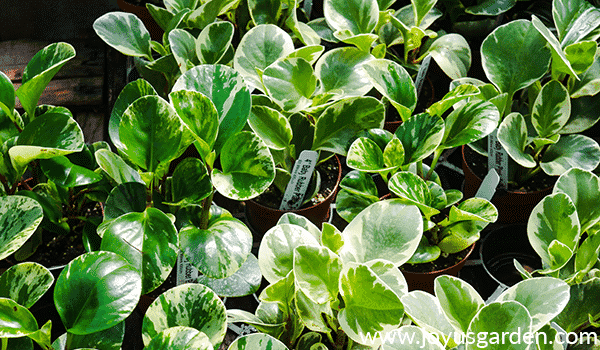
Pruning
Because peperomias are slow-growing, I don’t prune any of them often. I remove the occasional dying lower leaves and tip prune my Raindrop Peperomia and Baby Rubber Plant to control the size. The flowers drop off on their own.
Another reason to prune is to get stem cuttings for propagation.
See how I pruned & propagated my Baby Rubber Plant.
Propagation
You can propagate a peperomia by stem cuttings, leaf cuttings or by division.
Above is the link to pruning & propagating my Baby Rubber Plant. Here’s how I planted those Baby Rubber Plant cuttings.
Pests
My peperomias have never had pest issues, but I’ve heard they can sometimes be susceptible to mealybugs, spider mites, scale, and aphids.
It’s a good idea to keep an eye out—pests can spread quickly from one plant to another. If you do spot any unwelcome critters, insecticidal soap or neem oil usually does the trick for the ones listed above. Catching them early and taking action makes all the difference!
Safe for Pets
Good news: this is a plant that the ASPCA lists as non-toxic for both cats and dogs. If your pet likes to chew on plants, just know that it could make he or she sick.
Flowers
They aren’t like other flowers, and you could mistake them for a new leaf emerging. Mine bloom in spring and summer. All the flowers on my peperomias have been ivory or green.
Peperomia Care FAQs
Can peperomias be grown outdoors year-round?
In mild winter climates, yes. I grew a couple of them outdoors in my Santa Barbara, CA garden (zone 10b). Here in Tucson, AZ (zone 9a), no, I grow them indoors.
How can I tell if my peperomia is a crawler, trailer, or upright grower?
It’s not always easy to tell when peperomias are sold in small nursery pots—they often haven’t developed their full growth habit yet. What will be helpful is the botanical name, if it was included on the label when you bought the plant. With that, you can research the specific variety to learn more about how it grows.
Generally speaking, upright peperomias grow more vertically with thicker stems, while trailers have thin, flexible stems that naturally hang. Crawlers tend to grow low along the soil.
For example, my Baby Rubber Plant, which I’ve had for over eight years, started out upright but eventually developed semi-trailing stems as it matured. This is dependent on the environment and its age.
How do I encourage fuller, bushier growth in my peperomia?
If needed, I keep my peperomias fuller by pruning—either a bigger trim or tip pruning the end 1–4″. This encourages bushier growth. If yours is getting leggy, try moving it to a brighter spot with indirect sunlight. Not enough light causes plants to stretch out.
Why does my peperomia grow super slowly?
Peperomia plants are naturally slow-growing, especially the more compact varieties. They like a well-lit location and will grow even slower in lower light conditions.
Can I mix different peperomia varieties in one pot?
Not all peperomias have the same light needs, so be sure to check that along with their growth habits. You don’t want a more vigorous grower overtaking a compact variety. Peperomias are generally slow growers, so most can happily share a pot for a few years.
Peperomia Care Video Guide:
Conclusion: Peperomias are all about the foliage—you’ll find them in all sorts of textures, shapes, and colors. Many stay small, so you can easily tuck one (or a few) into your space. They like bright, indirect light (moderate light conditions) and don’t need a ton of water, let the soil dry out a bit between waterings to avoid soggy soil leading to root rot. Once you know what they like, peperomias care is wonderfully easy. They’ll bring their leafy beauty to your space all year long!
Happy gardening,

